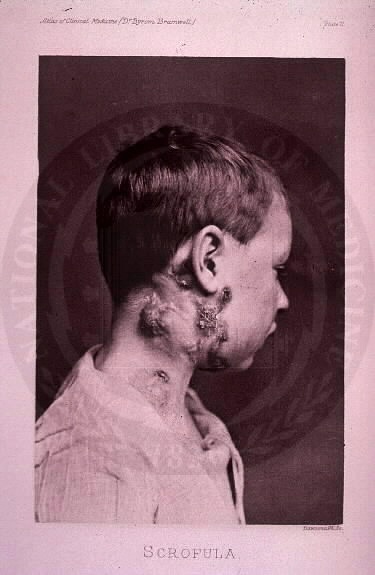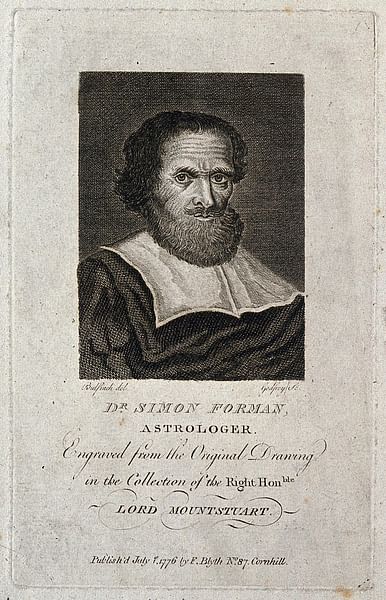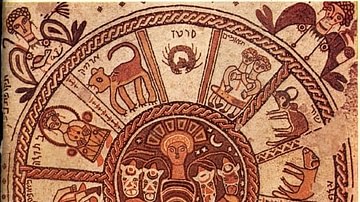
Simon Forman (1552-1611) was an Elizabethan physician, astrologer, magician, and alchemist who lived and worked in both London and Wiltshire, England. He was unusual in that despite receiving no formal training in medicine or astrology, and being repeatedly fined and arrested for practising, he grew to be a proficient and popular doctor, treating poor and rich alike.
Forman's casebooks reveal details of his thousands of clients, and his diary provides an invaluable insight into the period; including being one of the few first-hand accounts of watching William Shakespeare's plays and living through outbreaks of plague. His reputation was tarnished after his death, and it is only recently that his achievements are being recognised.
Astrology & Medicine in the 16th Century
During the 16th century, rather than being viewed as superstition, astrology was considered to be an important area of objective scientific study and even formed part of the training for doctors. Astrology and medicine were inexplicably entwined, with astrological almanacs providing the most beneficial days for operations, bloodletting, and purges, and indicating how each organ of the body was linked to an astrological sign.
Almost every court in Europe employed astrologers, and England was no exception with each Tudor monarch having engaged with them in some capacity. For example, John Dee, perhaps the most famous astrologer of the period, was in the service of Edward VI of England (r. 1547-1553), and then his successors Mary I of England (r. 1553-1558), and Elizabeth I of England (r. 1558-1603). Aristocrats also held professional astrologers in their employ, often desiring nativities (astrological birth charts) to be cast for their children. However, not everyone could afford the services of a highly trained astrologer or doctor, and that is where men such as Simon Forman came into play.
Early Life & Passion for Learning
Born in 1552 in Wiltshire, England, Simon Forman developed an early passion for learning which would drive him to seek knowledge his entire life. When he was eight years old, he attended the local school, and while he initially found spelling challenging, he claimed that a beating from the teacher resulted in his trying harder and thus becoming a better student. He asserted that he was his father’s favourite, but he had a strained relationship with his mother, and when his father died, to Forman’s anguish, she removed him from school (aged 11) and forced him to tend to the sheep and plough the fields. However, at the age of 14, he broke away from the drudgery of manual labour and apprenticed himself to Matthew Commin, a man of many occupations including hosier, cloth merchant, and seller of groceries and apothecary drugs.
Forman made the unusual arrangement with Commin that rather than be bound to apprenticeship for the typical seven years, he would remain for ten under the agreement he would be allowed to attend grammar school for the first three. However, this bargain does not appear to have been kept, and his precious books were confiscated. Luckily, a boy from the local grammar school began to board in his room and passed on to the eager young Forman the knowledge he had acquired each day. The apprenticeship ended abruptly in 1572 after a disagreement with his master’s wife lead to him being unfairly physically punished. Despite being 20 years old by this time, he returned to school.
Unsurprisingly, given his age and former resentments, his mother refused to support him during his return to education, and he was forced to work to survive - becoming a schoolmaster in charge of 30 boys. After six months, with two Oxford students as their benefactors, he and a friend travelled to Oxford and attended Magdalen College as 'poor scholars'. However, this venture amounted to little more than their being servants to the two young men who chose to hunt and socialise rather than study. With Forman’s dreams of furthering his education once again dashed, he returned to teaching in his hometown in 1574. At this point, he had begun to develop an interest in astrology, medicine, and magic, and while he desperately wanted above all things to be a scholar, he reached the conclusion that being an astrologer would be the next best thing.
From Practitioner to Prisoner
In 1579, after years of study but no formal training, Forman began practising astrology and medicine, performing a bloodletting on his first patient, John Waller. Following this, his services became popular, and he gradually began to make a name and income for himself. Unfortunately, this popularity began to attract the attention of the man who would for many years become his great opposition – Giles Estcourt, a local barrister and justice of the peace. Estcourt had Forman arrested for practising without a licence and imprisoned for over a year. During this time, all of his beloved, expensive books were stolen, and after emerging from jail, poor and back at square one, he decided to travel to London.
Soon after arriving in London, in 1580, he took up the opportunity to travel to the Low Countries for around a month, where he gained further knowledge of astrology. After returning home to Wiltshire he spent a year curing sick and lame folks and in one particularly graphic diary entry, he recalls treating a man suffering from scrofula (a tuberculosis infection of the lymph nodes in the neck, known at the time as the 'King’s Evil') where he claimed to have removed 86 worms from 24 holes in the man’s neck.
1582 marked a new chapter in his life, as at the age of 29, he first had sexual intercourse with a woman, and his diary, which begins the previous year, is littered with details of frequent love affairs with various women, both married and single, clients and acquaintances.
Over the course of the next five years, Forman continued to study and practice astrology, medicine, and magic, making many friends and enemies along the way. In 1587, he was once again imprisoned for illegally practising medicine and lost, yet again, all of his precious books. Undeterred as ever, he emerged from prison ready to continue his studies, and while most of the country was preoccupied with the threat of a Spanish invasion, during 1590, Forman was extending his magical education to include necromancy, attempting to call forth angels and spirits.
The late 16th century was wrought with events that were believed to be signs of God’s displeasure at humanity: the supernova of 1572, the great comet of 1577, an earthquake in 1580, the attempted invasion of the Spanish Armada in 1588, famine during the 1590s, and finally the plague which ravaged England in 1592-1593. It was during these plague years that Forman dramatically enhanced his reputation by curing himself of plague, via the lancing and dressing of sores and drinking the 'strong water' he had distilled, and also by remaining back to treat others when the majority of the licensed doctors had fled the city.
The College of Physicians
Over the next four years, Forman continued to see patients despite the college of physicians repeatedly fining and imprisoning him for practising without a medical licence. He never remained in prison for long, however, and was at this stage in his life in a position to take advantage of the monetary bribe system which operated in the prisons, meaning the brief times he did spend incarcerated were not the death sentences they were for many. By 1597, he was so well established with important figures, such as Robert Cecil (leader of the Privy Council) that the final attempt to have him arrested, failed.
The next few years of his life were incredibly fruitful. After years consulting the stars for a good fit, he was finally wed in 1599, aged 47, to the 17-year-old Jean Baker. Despite this new status, however, married life never prevented him from pursuing relationships with various other women. By 1600, he was openly celebrating how much money he was making, and he wrote of 1601 as the year when he thrived. He purchased clothing, jewels and in a bid to confirm his position he had his portrait drawn.
He continued to treat all manner of illnesses for the young and old, including headache, stomach pain, fevers, cancerous lumps, and menstrual and pregnancy issues. Forman began to collect many rich and powerful clients, such as George Talbot, the Earl of Shrewsbury, son-in-law to Bess of Hardwick – one of the wealthiest women in England. However, most of his clients continued to be of the lower classes, and he frequently treated the poor for free. When the college of physicians issued one final summons, he simply refused to go.
Aside from his medical skills, his services as an astrologer also continued to be in demand, for example, clients often called on him to uncover stolen items, and wives of sailors sought him out to discover when or if their husbands would return to them. Elizabethan England also had an obsession with buried treasure, and he received many requests to use his astrological castings to determine if any jewels would be uncovered in the clients' gardens or beneath floorboards.
Endings & Beginnings
1603 was a momentous year for Forman. While most would remember it as the year Queen Elizabeth I died leaving King James VI of Scotland to rule England (r. 1603-1625), Forman had his dream finally realised - after 20 years of illegally practising as a doctor, he received a licence from the University of Cambridge, which allowed him to now practice officially, although this did not stop the college of physicians attempting to summon him over the next four years.
Plague also returned in 1603, and as in the previous decade, Forman remained in his town to treat the victims. While he saw through the plague unscathed, his 18-year-old illegitimate son Joshua, who had lived with him since his mother died two years prior, succumbed and died quickly. Further heartbreak ensued when his wife finally conceived and gave birth in 1604 to her first child, Dorothy, who died aged six months. However, a son, Clemmonte, was born in 1606 who grew to be strong and healthy and seemed destined to follow in his intelligent father’s footsteps, as Forman proudly wrote that he was reading by the age of five.

In the final years of his life, he continued to diligently treat patients and work proudly on his garden. He died on 1 September 1611, on the exact day he had predicted one week prior, despite being in seemingly excellent health at the time.
Forman’s Legacy
By the end of his life, Simon Forman had, against the odds, achieved almost everything he set out to as a young man: he had established himself as a respected and popular physician and astrologer, he had a formidable career which had made him reasonably wealthy, he had a fine home, a wife and son, and could call himself a gentleman. This should have been the way he was remembered, however, due to his involvement with one particular client, his well-deserved positive reputation has not stood the test of time.
In the years that followed his death his name began to be implicated, seemingly unfairly, in the trial of the murder of the poet Thomas Overbury in 1613. Forman’s former client, Frances Howard, the Countess of Essex, wife of Robert Deveraux, had been found guilty of killing Overbury, who had objected to her estrangement from her husband. During the trial, numerous strange objects found within Forman’s house were presented as a means to implicate him as practising black magic and to suggest that his involvement with Francis had been a sinister one, in assisting the murder. When the items, which included a wax doll and a piece of parchment with skin attached, were presented - a loud crack supposedly resounded through the rafters. This one incident, occurring two years after his death, lead to the enduring understanding of Forman’s career as a caster of false horoscopes and a medical ‘quack’.
More recently, however, after 400 years of being described as a fraud, his contributions to medicine and his community are beginning to be recognised. While he clearly had a high opinion of himself and his seduction of women is morally questionable, his case notes and autobiography present him as a genuinely caring doctor whose patients were never simply an income and demonstrate that even those born in the lowliest of circumstances could lift themselves with education, a little luck, and a great deal of utter stubbornness.










